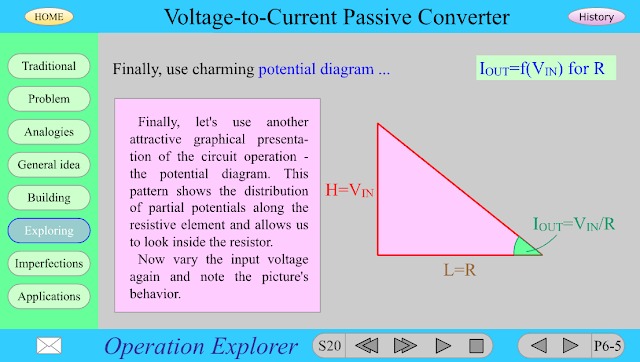What are voltages inside resistors?
See also a related RG discussion and Codidact paper.
Need to visualize voltage distribution
Once visualized the voltages of the internal circuit points, we can go even further and "enter" inside resistors to visualize the voltages across the resistive film. This will allow us to see some interesting points (for example, virtual ground), the operation of well-known electrical devices (potentiometer, resistive summer) and electronic circuits (inverting, non-inverting, differential and instrumentation amplifiers).
First ideas
This idea came to me in the early 90's. Then, for the purposes of intuitive understanding, I began representing local voltages inside resistors by a set of vertical segments whose length (height) was proportional to the local voltage magnitude (I named it voltage diagram). This notion of voltage came from a hydraulic analogy (a garden hose with evenly drilled holes) which I had seen in an old Electrical Engineering textbook. See, for example, an yellowed sheet of paper from my archive where, in 1990, I drew the voltage diagram of a resistor voltage summer:
It is more convenient to display only the shell of the diagram. Thus a triangle is obtained in which the vertical leg is the voltage V, the horizontal leg is the resistance R, and the angle between the hypotenuse and the horizontal leg represents the current I (another geometric representation of Ohm's law, see the Flash picture below).
I have developed various kinds of voltage diagrams. I colored them in red (an association with pressure) to easily distinguish them from circuit diagrams drawn in black.
Sophisticated voltage diagrams
Later, I drew more sophisticated current pictures by means of Corel Draw. See, for example, the circuit of a voltage divider with constant input voltage VREF (applied from the left)...
"Live" voltage diagrams
In 2000, I made Flash animated circuit tutorials with "live"voltage diagrams that were changing proportionally to the voltage magnitude (you need Ruffle Flash emulator to see this movie because Adobe Flash player is no longer supported).
"Reallly live" voltage diagrams
But then I had the desire to make "really live" voltage diagrams that use actually measured voltages at several base points in the circuit. For this purpose, I used MICROLAB data acquisition system (see the Wikibooks story about Ohm's experiment and the detailed 5 min movie). In this attractive experiment, a linear potentiometer was supplied by two DACs and the voltages of its three terminals (E1 of the left end, E2 of the right end and E3 of the wiper) were measured by three ADC inputs. The other points of the voltage diagram were calculated. Also, conventional voltmeters were connected:
When E1 and E2 had opposite polarities, the famous virtual ground appeared:
The content is more important than form
But, as in the case of current loops and voltage bars, I finally came to the conclusion that content was more important than form... and I began to draw circuit diagrams with superimposed voltage pictures by hand. For example, in the Wikibooks story about Ohm's experiment, I have drawn the voltage diagrams by color fiber pens on a white sheet of paper. Here is an example of a voltage divider with constant input voltage V...
... and of a resistor summer with oppositely varying input voltages Vin1 and Vin2 (an illustration of an op-amp voltage inverter):
Voltage diagrams vs voltage bars
The voltage diagram is based on a linearly distributed resistance along the length of the resistor. In most cases this representation is artificial, because ordinary resistors in electronic circuits are discrete; but it allows to illustrate the circuit operation with voltage diagram. In many cases, quantitative parameters (transfer ratios, etc.) can be directly seen.
An oscillogram is a set of points that represent voltages (by a vertical displacement) at successive points in time through. So, the particular segments of a voltage diagram represents the voltages at particular points of the resistive layer at the same time while the oscillogram shows the voltages at one point but at different points in time.
Helping the online learning
As I have said in the stories about current loops and voltage bars, a year ago, when we switched to online learning, I started using the ZOOM pen to draw on existing web circuit diagrams. This turned out to be a very powerful didactic technique that I managed to improve even more on the last exercise. I will show you how this happened at the final part of the last exercise (01.11.21) on Semiconductor Devices with group 49a, ITI, FCST of Technical University of Sofia. I make full video recordings of ZOOM meetings with my students and, with their permission, I will use a link to the latest record (in Bulgarian). Here is also a snapshot of ZOOM whiteborad (really, the picture is not so beautiful... but attractive:-)
It will be interesting for me to know your opinion about this didactic technique.










Comments
Post a Comment